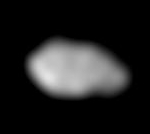 Image taken by Galileo's Solid State Imager between November 1996 and June 1997 | |
| Discovery | |
|---|---|
| Discovered by | S. Synnott |
| Discovery date | 4 March 1979 |
| Designations | |
| Pronunciation | /ˈmiːtəs/[1] |
Named after | Μήτις Mētis |
| Adjectives | Metidian, Metidean /mɛˈtɪdiən/ |
| Orbital characteristics | |
| Periapsis | 127974 km[a] |
| Apoapsis | 128026 km[a] |
Mean orbit radius | 128000 km (1.792 RJ)[2][3] |
| Eccentricity | 0.0002[2][3] |
| 0.294780 d (7 h, 4.5 min)[2][3] | |
Average orbital speed | 31.501 km/s[a] |
| Inclination | 0.06° (to Jupiter's equator)[2][3] |
| Satellite of | Jupiter |
| Physical characteristics[4] | |
| Dimensions | 60 km × 40 km × 34 km |
| 21.5±2.0 km | |
| ≈ 6200 km2[a] | |
| Volume | ≈ 42700 km3[a] |
| Mass | ≥6.4×1016 kg[a] |
Mean density | ≥1.5 g/cm3 |
| ≥0.8 cm/s2 (average) | |
| synchronous | |
| zero | |
| Albedo | 0.061±0.003[5] |
| Temperature | ≈ 123 K |
Metis /ˈmiːtəs/, also known as Jupiter XVI, is the innermost known moon of Jupiter. It was discovered in 1979 in images taken by Voyager 1, and was named in 1983 after the Titaness Metis, the first wife of Zeus and the mother of Athena. Additional observations made between early 1996 and September 2003 by the Galileo spacecraft allowed its surface to be imaged.
Metis is tidally locked to Jupiter, and its shape is strongly asymmetrical, with the largest diameter being almost twice as large as the smallest one. It is also one of the two moons known to orbit Jupiter in less than the length of Jupiter's day, the other being Adrastea. It orbits within the main ring of Jupiter, and is thought to be a major contributor of ring material.
- ^ Noah Webster (188). A Practical Dictionary of the English Language.
- ^ a b c d Evans Porco et al. 2002.
- ^ a b c d Burns Simonelli et al. 2004.
- ^ Thomas Burns et al. 1998.
- ^ Simonelli Rossier et al. 2000.
Cite error: There are <ref group=lower-alpha> tags or {{efn}} templates on this page, but the references will not show without a {{reflist|group=lower-alpha}} template or {{notelist}} template (see the help page).